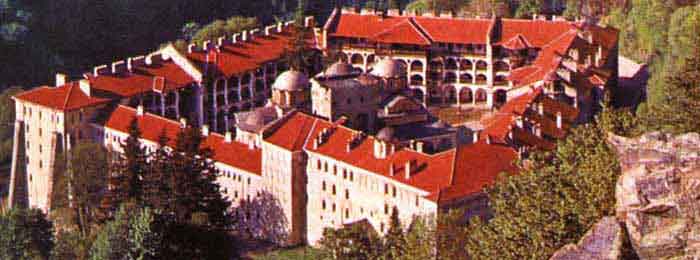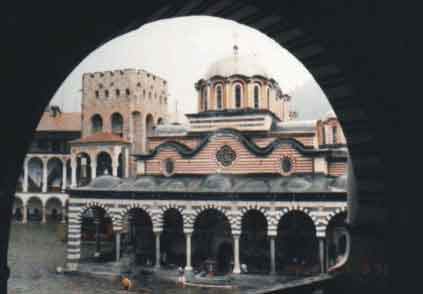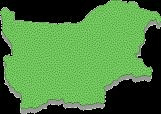|
|
Every three hours the bells of the Rila Monastery mark the passage of time, taking us to that
unknown, which we call eternity. When you measure time with the chime of
bells, it assumes a slow, biblical aspect, and man, living at the rapid pace of our
civilization, is eager to grasp the opportunity of spending a day of
leisure, This day is exceedingly long from sunrise to sunset, full of cool mountain
breezes, the rustle of deep forests and the scent of moss and crane's-bill.
The Rila Monastery is a place for hermits and
runaways. Man has always tried to escape from something, and the absurdity of this escape has led him to change his mode of
life. If this had not been so, the Rila Monastery would not have come into
being.
We go to this monastery as tourists, out of curiosity, or because we are thirsty for
knowledge. But there everything changes. An indistinct feeling of being alienated from the
world, puts us into contact with our own self, and with an intensified sensibility we begin to discover
things, which hardly exist.

Evening sets in slowly here, with that indescribable chastity which we discover when we are alone among nature. The mountain becomes
blue, on the verge between day and night the murals assume sharp contours, and a few moments later this sharpness begins to
disappear. Footsteps resound along the wooden verandas of the monastery, but they reach your ear as an echo from another
world. A door, banged shut, reminds you of dark passageways and vast rooms once inhabited  by
rulers. The past and the present are projected in your mind and you stand crucified between the ages. The moon wrests itself with difficulty from the clouds and its dead light sprays the mountain with silver
dust. Hrelyo's Tower which has stood solid and immobile for centuries, looks petrified from the cold of its
walls. by
rulers. The past and the present are projected in your mind and you stand crucified between the ages. The moon wrests itself with difficulty from the clouds and its dead light sprays the mountain with silver
dust. Hrelyo's Tower which has stood solid and immobile for centuries, looks petrified from the cold of its
walls.
The Rila hermit St. John came to the inaccessible mountain to voice his protest against medieval
obscurantism. These are the facts, but they are actually impulses, which are motivated by the person. St. John of Rila was escaping from the world to establish a distance between it and
himself, to evaluate it morally and make an epoch. He was a hermit, but as he was conscious of the fact that he was making an
epoch, he sought for a material expression of his protest. Thus, in the 10th century he laid the foundations of the
monastery.
St. John of Rila was a myth and a yardstick by which consciences were
measured. He knew perfectly well that he could not make hermits of all the
people, but he must have understood the loftiness of his self-denial which was to be adopted later by the Bulgarians in their search for moral
values, because people get passionately attached not to something over which they have power, but to what is beyond their
possibilities. If this is a complex, it is the same complex which urged Tsar Peter, who ruled then in Tarnovo Bulgaria's medieval
capital, to set out to look for the strange hermit His dignity of ruler made him stop high up on a
peak: the two men, both proudly conscious of their worth, stood separated by a few
ridges, but neither made a step towards the other.
At any rate, the monastery was built at the site where the holy man went into
exile, and, in one form or another it lasted through the ages to delight the visitor till today with its imposing
beauty.
Protosebast Hrelyo was a Bulgarian feudal lord of the 14th century. Next to the cross and the biblical
texts, he held the parchments written by copyists within the boundaries of his little
realm. The 14th century was marked by invasions and by rapidly changing
frontiers, the downfall of despots and the ascent of new princes. He had seized earthly power but had lost the mystic forces which John of Rila possessed Next to the hermit's grave, Hrelyo raised a tower whose construction now nails us to the spot in dumb
contemplation.
The rough-edged stones seem to be outlining the sharp profile of the legendary despot. He was an earthly feudal lord and realized that near the fulcrum around which swung the arms of the balances, the swinging was not fatal. Thus he settled down between Tsar Ivan Alexander and Stefan
Dushan. Each one of the two reckoned on being able to use him while he received and sent back gifts. But when the game became too
protracted, one night he was stifled and all that was left of him was an Inscription on a
tombstone.
This tombstone now is in the monastery museum. On the inscription the wife of the despot "is still sobbing and weeping
bitterly, steeped in sorrow." For us this is history, but history would lose Its sense if present-day reality did not bind us to
it.
Hrelyo's throne and the altar gates of his church are also museum relics. The chisel of a great master carved the wood which was destined to survive through the ages and come down to
us.
Invasions shook Bulgaria and the walls of the monastery crumbled to ruins. The Rila Monastery rose from the
ashes, collapsed in ashes and was again rebuilt. The last restoration was remarkable, because it marked the revival of the whole nation. Only the liberated consciousness of a nation can turn a construction project into an architectural
wonder. Nothing can be created without a spark in the mind, because it is an idea that seeks to be
materialized.
Alexi Rilets and Master Milenko looked for the points of support in the terrain and their restless imagination came to that indescribable irregular pentagon, the two-meter walls of which have for a century end a half been enclosing the monastery yard. This asymmetry was a rejection of geometrical proportions which made the building an embodiment of the builder's
feelings.
Somewhere in the northern corner stood hidden the old monastery mill. Master Alexi whimsically gave a utilitarian solution to the architectural problem by avoiding a quadrangular
courtyard.
Angular branches creep up on the outside of Hrelyo's Tower ending in the upper part into tile
vaults. The columns are also both points of support for the battlements and a means of
defense, as well as an artistic solution of the play of light and shadow. Master Alexi submitted to their suggestion, breaking the rhythm of the wooden arcade to make it a part of the ancient
tower.
Milenko was not so much of a mason as he was a poet. The big stone stands as a part of the
decoration, the small stones making up its natural environment in which it ceases to be a
stone. Fortress walls, yes. but warm walls, predisposing and enticing you to look beyond them and promising to turn the mystery into a revelation The masons finished their job. Krustyo of Debur arrived to crown the walls with wooden verandas,
wood carved consoles and
capitals. Functional demands were combined with decorative principles. You pass along the verandas: the floor boards squeak a
little. You stand bewitched and then you cannot get rid of the thought that all this fantastic world which was built so long ago is also meant to give you
pleasure. Water is bubbling somewhere in the cobbled courtyard as in the first day of
creation. The old manuscripts and murals cannot be seen neither can you see the little
chapels, hidden in the verdure of the mountain, but you are aware of their
presence. You can see them all in the exhibits at the museum: Tsar Ivan Shishman's Charter with which he donated lands to the monastery in the 14th
century; Raphael's cross whose maker for 12 years in succession carved Biblical scenes with a pin on a piece of linden wood until he became blind; the simple-minded popular life of St. John of Rila dating from the 12th
century; the saint's icon with the naive miniatures around it, the lines of which show us the loss we incur by gaining
knowledge.
|


 by
rulers. The past and the present are projected in your mind and you stand crucified between the ages. The moon wrests itself with difficulty from the clouds and its dead light sprays the mountain with silver
dust. Hrelyo's Tower which has stood solid and immobile for centuries, looks petrified from the cold of its
walls.
by
rulers. The past and the present are projected in your mind and you stand crucified between the ages. The moon wrests itself with difficulty from the clouds and its dead light sprays the mountain with silver
dust. Hrelyo's Tower which has stood solid and immobile for centuries, looks petrified from the cold of its
walls.